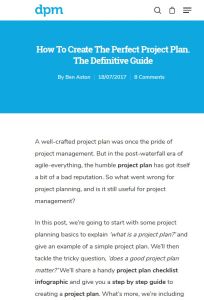Join getAbstract to access the summary!

Join getAbstract to access the summary!
Ben Aston
How to Create the Perfect Project Plan
The Definitive Guide
Digital Project Manager, 2017
What's inside?
Projects in today’s agile work environments can benefit from good old-fashioned project planning.
Recommendation
Technology and work environments may have changed radically, but if you’re a project manager, you face the same basic tasks and questions as your predecessors a generation ago: defining the project’s purpose and phases, predicting resource needs, accurately estimating time and costs, winning client buy-in, and keeping the team working together and on track. On his blog The Digital Project Manager, Ben Aston argues for good old-fashioned project planning as an essential tool for project management, even in today’s agile IT development environments. Aston gives the whys and wherefores of project planning and lists 10 steps to doing it well.
Summary
About the Author
Ben Aston is a digital project manager with 10 years’ experience working with digital agencies in London.

















Comment on this summary